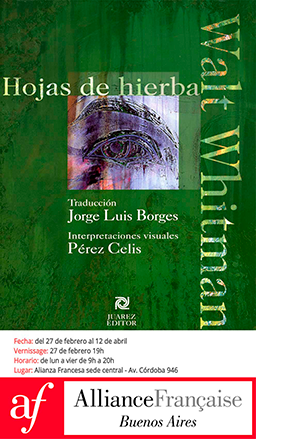PERUVIAN AMAZONIAN ART THROUGH THE HOCHSCHILD CORREA COLLECTION
The Hochschild Correa Collection boasts of being the most complete private collection of contemporary art from the Peruvian Amazon. Nevertheless, for more than a decade, it has been built on a varied and unrestricted collection, which has made it possible to bring together the different trends and techniques currently being used in the region, with a focus on dialogue and a certain relational patina among the works that make up the collection.
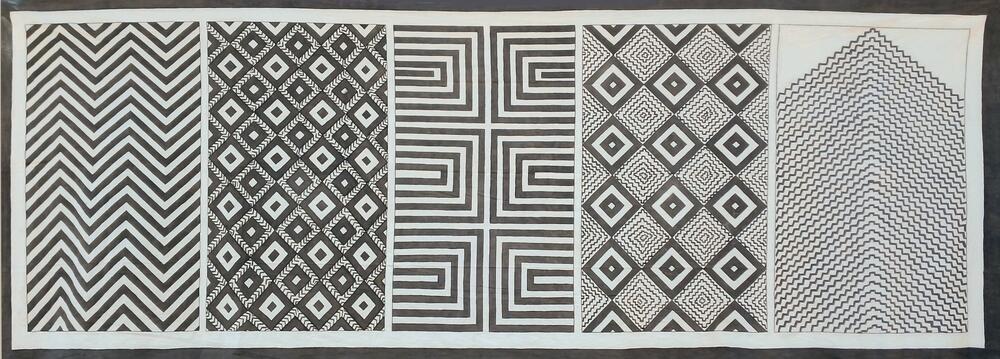
Amazonía Contemporánea (Contemporary Amazonia), the title under which part of the collection is on display at Madrid's Lázaro Galdiano Museum, allows us to delve into that prolific production, braiding its anthropological and esthetic bases to understand the realities of the artistic ecosystem. Drawing political lines over a broad geography can have its risks. Let's assume that the division of modern states over indigenous cartography is an aberration in itself, but it may be justified if what is valued is the relationship to colonial heritage or the strength to maintain the identity of each community.
Curated by Christian Bendayán and Luis Pérez Oramas, the exhibition traces the attitude and evolution of recent Peruvian art produced in the Amazon through the work of artists from different generations, which also facilitates the understanding of the concerns, themes and techniques, as well as their cultural background. It is also perceived the idea of unifying a local criterion, bringing together the proposals more rooted in the primitive with the more urban processes.
-
Luis Martínez Dávila. La última cena Shipiba, 2013. Óleo sobre lienzo,
70 x 100 cm -
Luis Martínez Dávila. La última cena Shipiba, 2013. Óleo sobre lienzo,
70 x 100 cm -
Enrique Casanto. Cosmovisión asháninka
-
Pablo César Amaringo Shuña. La danza de los puca bufeos
-
Dimas Paredes. El lago prohibido
-
Mary Rodríguez. Diseño Iskonawa
This is where the themes are concentrated, the natural techniques used by Chonon Bensho as opposed to the use of other more artificial materials to give life to works that inherently maintain cohesion with the territory and point to the different ways of conceiving cosmography and cosmocentrism. In that own belief, the works of Smith Churay or Enrique Casanto turn to their own imaginary, without borrowings, purer in essence, while Luis Martinez Davil raises the religious syncretism as an identity, perhaps not so primitive, but equally validated by history.
Obviously, the tour leaves room for reflection on the transfers of aesthetics and their ways of representation. The importance of nature and its patterns and how these are understood within the most primitive system could clash against the evidence that, increasingly, reiterates that part of the contemporary western movements find their roots in that original essence. Fauvism and abstract geometry recognize their discovery in dreamlike pictorial techniques and magical content, but works such as those of Pablo César Amaringo Shuña or Dimas Paredes, for the former, or those of Olinda Silvano or Mary Rodríguez, for the latter, raise the question of whether, at present, the sense of direction is unique.
The Peruvian Amazon shapes in its most current art an enriched and enriching world, which advocates a result united by the ancestral elements and by the lived history (and here the geopolitical division does make sense) and which debates between functionalism and aesthetics and which vindicates that conjunction with the natural, with spirituality and the exuberant, with that world that, whether with embroidery, wood or photographs, point in the same direction with multiple historiographic and, above all, anthropologically based edges.
Amazonía Contemporánea. Colección Hochschild Correa - Perú can be visited until April 6 at the Museo Lázaro Galdiano, Serrano, 122, Madrid (Spain).
Related Topics
May interest you

The Lima Art Museum (MALI) has announced the return of its emblematic event, thanks to the sponsorship of BBVA Global Wealth and RIMAC. The showcase will take place on February 21 at Playa del Golf, in the Asia beach resort.
CELEBRATING PERUVIAN ART: MALI'S SUMMER AUCTION RETURNS
The Lima Art Museum (MALI) has announced the return of its emblematic event, thanks to the sponsorship of BBVA Global Wealth and RIMAC. The showcase will take place on February 21 at Playa del Golf, in the Asia beach resort.

The Lima Art Museum (MALI) has announced the return of its emblematic event, thanks to the sponsorship of BBVA Global Wealth and RIMAC. The showcase will take place on February 21 at Playa del Golf, in the Asia beach resort.
CELEBRATING PERUVIAN ART: MALI'S SUMMER AUCTION RETURNS
The Lima Art Museum (MALI) has announced the return of its emblematic event, thanks to the sponsorship of BBVA Global Wealth and RIMAC. The showcase will take place on February 21 at Playa del Golf, in the Asia beach resort.
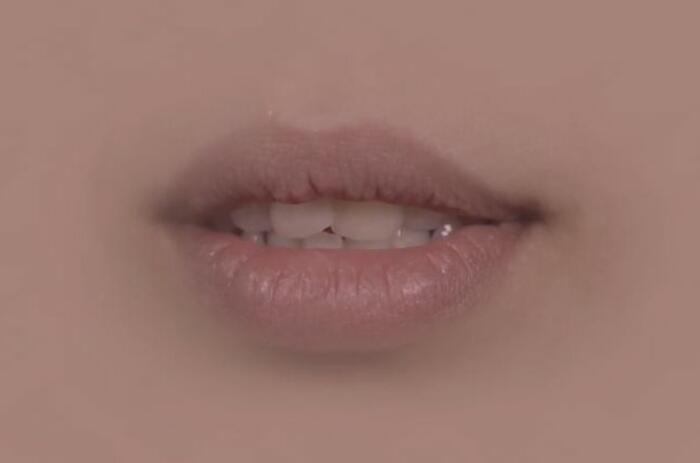
The work that Lúa Coderch (Iquitos, Peru, 1982) has been doing around language takes over her recent solo show at Madrid's The Ryder Projects to consolidate a new relational vision of communicative practices. Exhausted and exuberant, title of this partially retrospective and almost thesis exhibition, also responds to the two apparently opposite moods, but with an inexorable link, of the vital needs that seep into contemporary society between individuals and a certain extimacy that, organically, seems to have been imposed.
LANGUAGE AND SOCIETY IN LÚA CODERCH'S WORK AT THE RYDER
The work that Lúa Coderch (Iquitos, Peru, 1982) has been doing around language takes over her recent solo show at Madrid's The Ryder Projects to consolidate a new relational vision of communicative practices. Exhausted and exuberant, title of this partially retrospective and almost thesis exhibition, also responds to the two apparently opposite moods, but with an inexorable link, of the vital needs that seep into contemporary society between individuals and a certain extimacy that, organically, seems to have been imposed.
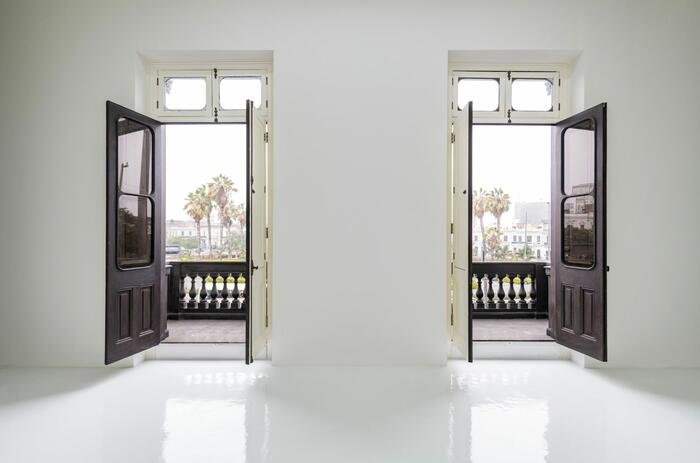
At Plaza Bolognesi, in the historic center of Lima, has opened GATO. Co-founded by Axier Villanueva and Oscar Flórit, this art platform seeks to sustain a dynamic, institutional-level program in a unique commercial environment.
GATO: THE GALLERY THAT SEEKS TO GENERATE NEW DIALOGUES IN PERU
At Plaza Bolognesi, in the historic center of Lima, has opened GATO. Co-founded by Axier Villanueva and Oscar Flórit, this art platform seeks to sustain a dynamic, institutional-level program in a unique commercial environment.
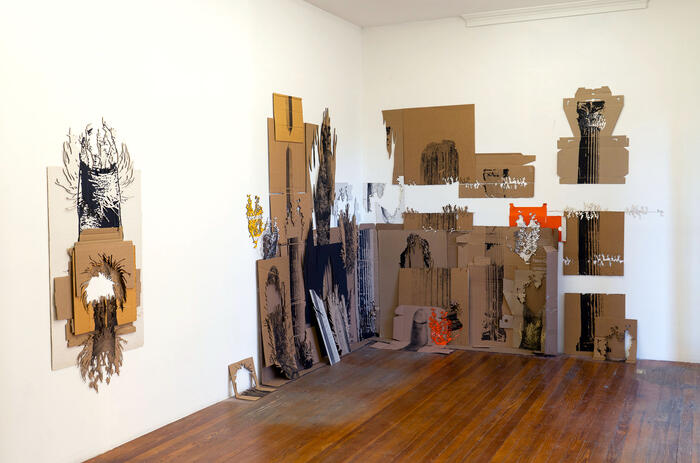
The VIGILGONZALES gallery presents Ansío lo que crece mientras cae (I Long for What Grows While Falling), an individual exhibition by Peruvian artist Natalia Iguiñiz Boggio; it highlights, both from a personal perspective and through historical reflection, the symbolic and epistemological aspects that uphold the vertical order of the patriarchal system.
VERTICAL ORDER AND CARDBOARD: NATALIA IGUIÑIZ AT VIGILGONZALES
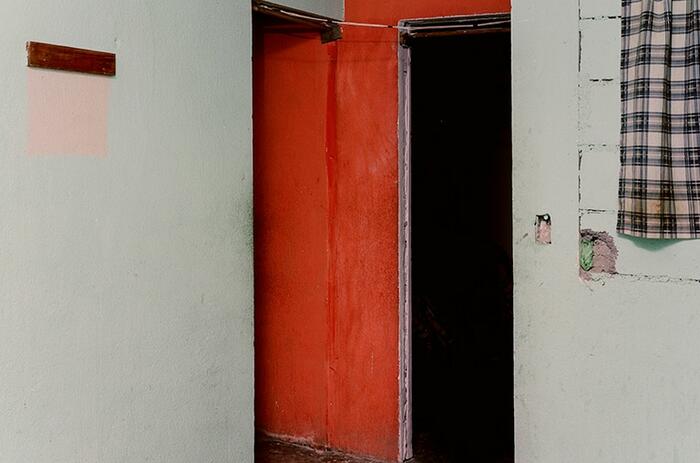
Felipe Romero (Bogota, Colombia, 1992) usually shows in his photographic proposal a high interest in conflict zones. While the scenario reflects this palpable but still intangible tension, it also serves as a reflective framework where the conflict and its protagonists meet.
BORDER HOPELESSNESS THROUGH THE LENS OF FELIPE ROMERO
Felipe Romero (Bogota, Colombia, 1992) usually shows in his photographic proposal a high interest in conflict zones. While the scenario reflects this palpable but still intangible tension, it also serves as a reflective framework where the conflict and its protagonists meet.
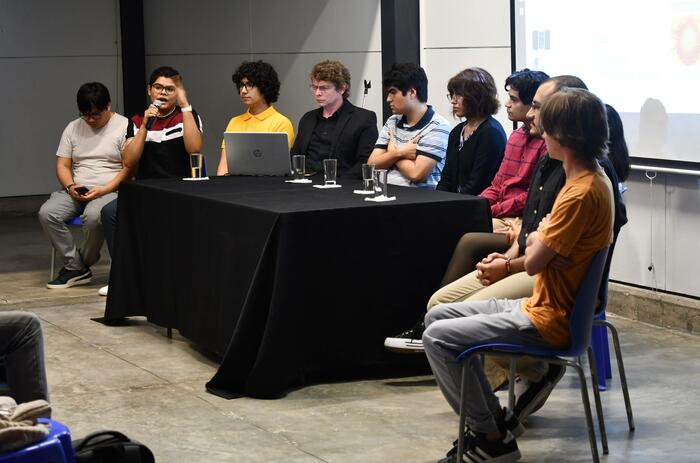
The Museum of Contemporary Art of Lima (MAC) is organizing New Horizons of Digital Art, aimed at young people and adults, as part of the public program of the exhibition Artware 9. Lima Digital Art Biennial.
DIGITAL ART EXPANDS IN PERU
The Museum of Contemporary Art of Lima (MAC) is organizing New Horizons of Digital Art, aimed at young people and adults, as part of the public program of the exhibition Artware 9. Lima Digital Art Biennial.
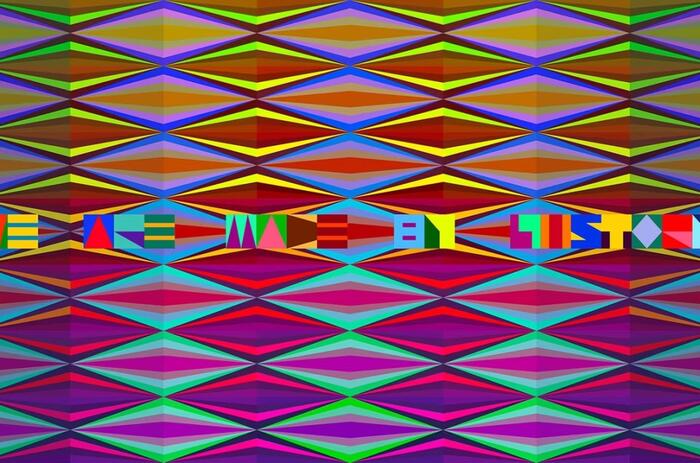
The Broad Museum is set to present Jeffrey Gibson: the space in which to place me, a special exhibition showcasing the artist’s multidimensional work. Adapted from its original presentation at the U.S. Pavilion at the 60th Biennale in 2024, this exhibition marks a historic moment—Gibson was the first Indigenous artist to represent the United States with a solo exhibition.
JEFFREY GIBSON IN LOS ANGELES: A KALEIDOSCOPE OF IDENTITY AND RESISTANCE
The Broad Museum is set to present Jeffrey Gibson: the space in which to place me, a special exhibition showcasing the artist’s multidimensional work. Adapted from its original presentation at the U.S. Pavilion at the 60th Biennale in 2024, this exhibition marks a historic moment—Gibson was the first Indigenous artist to represent the United States with a solo exhibition.
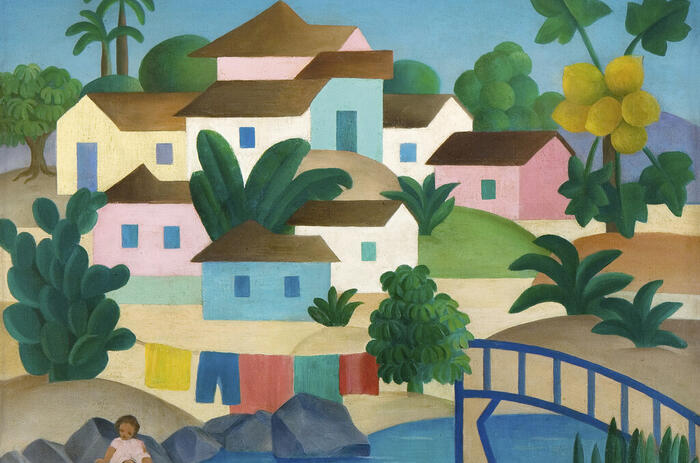
The Guggenheim Museum Bilbao hosts a retrospective exhibition of Tarsila do Amaral (Capivari, Brazil, 1886 - São Paulo, Brazil, 1973) focused on her conception and renovation of painting, as well as on her recognition as one of the key and most representative figures of the entry of avant-garde and modernizing pictorial languages in Latin America. A central name in Brazilian modernism, her style was consecrated as her own identity, a product of her desires and experiences, evoking both indigenous themes and the modernizing processes of a Brazil that was undergoing a constant transformation.
THE MODERNITY OF TARSILA DO AMARAL TAKES OVER THE GUGGENHEIM IN BILBAO
The Guggenheim Museum Bilbao hosts a retrospective exhibition of Tarsila do Amaral (Capivari, Brazil, 1886 - São Paulo, Brazil, 1973) focused on her conception and renovation of painting, as well as on her recognition as one of the key and most representative figures of the entry of avant-garde and modernizing pictorial languages in Latin America. A central name in Brazilian modernism, her style was consecrated as her own identity, a product of her desires and experiences, evoking both indigenous themes and the modernizing processes of a Brazil that was undergoing a constant transformation.
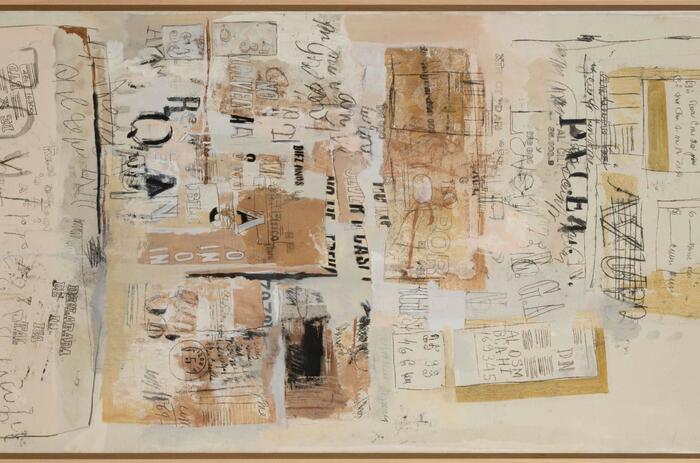
Madrid-based Maisterravalbuena proposes a vindication of the work of Sarah Grilo (Buenos Aires, Argentina,1917 - Madrid, Spain, 2007) through Soluciones para pensar, the second exhibition on this artist at the gallery. With a didactic and rediscovery vocation, the exhibition gathers a selection of paintings in different formats made between the 1960s and 1990s, many of them unpublished to the public. This work of selection and direct work of the gallery with the archive and the legacy of the Argentinean artist becomes fundamental in the structuring of the objective of creating opportunities for a greater knowledge of Grilo's work.
(RE)DISCOVERING SARAH GRILO AT MAISTERRAVALBUENA
Madrid-based Maisterravalbuena proposes a vindication of the work of Sarah Grilo (Buenos Aires, Argentina,1917 - Madrid, Spain, 2007) through Soluciones para pensar, the second exhibition on this artist at the gallery. With a didactic and rediscovery vocation, the exhibition gathers a selection of paintings in different formats made between the 1960s and 1990s, many of them unpublished to the public. This work of selection and direct work of the gallery with the archive and the legacy of the Argentinean artist becomes fundamental in the structuring of the objective of creating opportunities for a greater knowledge of Grilo's work.
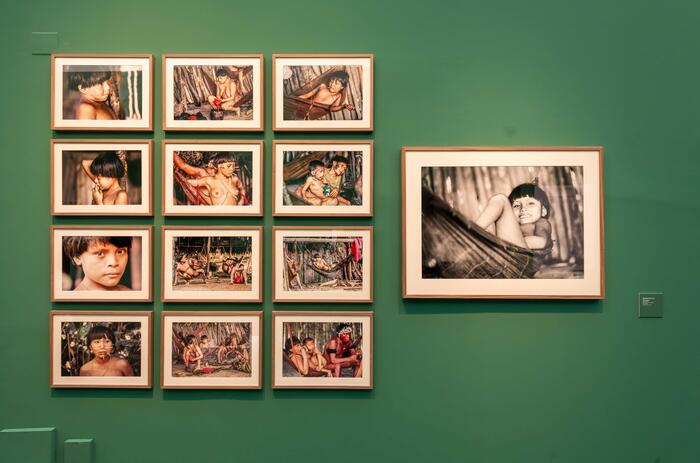
Madrid's CentroCentro approaches the artistic production related to the Amazon with the exhibition Trópico sin tópico: Amazonas (Tropic without Topic: Amazon), curated by Halim Badawi (Barranquilla, Colombia, 1982), and with which it intends to facilitate new looks beyond the usual ones with which the European imaginary contemplates the indigenous legacy and its relation with the contemporary world.
THE REVERSION OF AMAZONIAN CLICHÉS AT CENTROCENTRO
Madrid's CentroCentro approaches the artistic production related to the Amazon with the exhibition Trópico sin tópico: Amazonas (Tropic without Topic: Amazon), curated by Halim Badawi (Barranquilla, Colombia, 1982), and with which it intends to facilitate new looks beyond the usual ones with which the European imaginary contemplates the indigenous legacy and its relation with the contemporary world.
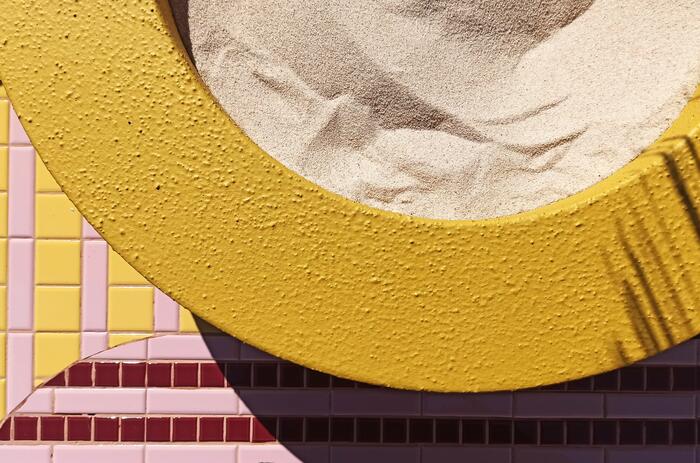
The intervention Wasi Llamkha (Place and touch), by artist Andrea Canepa (Lima, Peru, 1980), stands on the South Patio of Madrid's Condeduque. This pavilion, designed as an ephemeral architectural structure, invites us to explore its sensorial value, far from the preeminence of the visual, and claims, by way of inspiration, the quipus, the forms of representation and recording of information from pre-Columbian Peru.
SPACE AND SENSES IN ANDREA CANEPA
The intervention Wasi Llamkha (Place and touch), by artist Andrea Canepa (Lima, Peru, 1980), stands on the South Patio of Madrid's Condeduque. This pavilion, designed as an ephemeral architectural structure, invites us to explore its sensorial value, far from the preeminence of the visual, and claims, by way of inspiration, the quipus, the forms of representation and recording of information from pre-Columbian Peru.
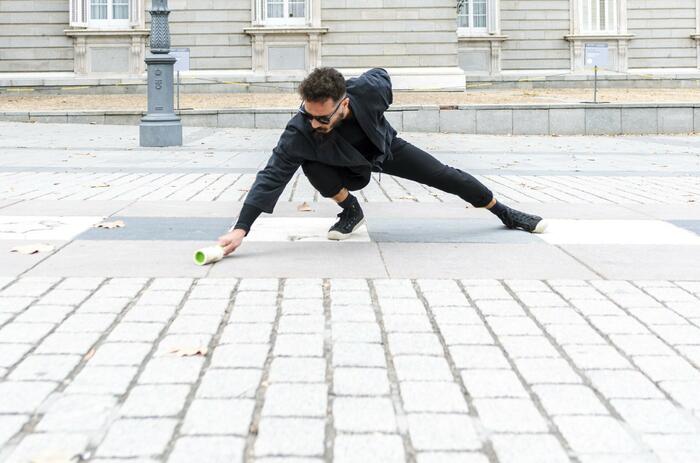
Intricate between action and register, El Apartamento hosts Algo deja quien se va, the first solo exhibition in Spain by Reynier Leyva Novo (Havana, Cuba, 1983). Starting from the political concept of historical memory and linking it to the issues of power and colonialism, the artist unfolds in two well-differentiated series his proposal to approach these lines, and extends his networks to the impact (or influence) they have on the institutional and cultural fabric.
LEYVA NOVO: DUST IT IS AND TO DUST IT WILL TURN
Intricate between action and register, El Apartamento hosts Algo deja quien se va, the first solo exhibition in Spain by Reynier Leyva Novo (Havana, Cuba, 1983). Starting from the political concept of historical memory and linking it to the issues of power and colonialism, the artist unfolds in two well-differentiated series his proposal to approach these lines, and extends his networks to the impact (or influence) they have on the institutional and cultural fabric.
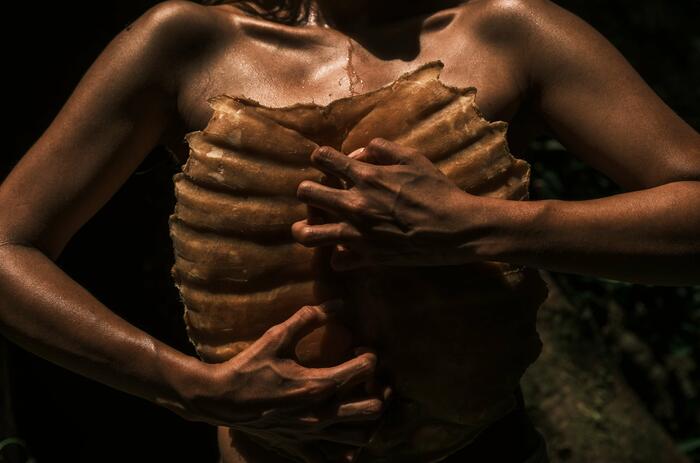
With an innovative perspective and a personal scenic language, KAY presents a play that reveals how the myths of the Amazon have been distorted to conceal the violence lurking over the women and girls of the region. The performance will serve as the closing event of the tenth edition of the prestigious theater and dance festival Temporada Alta, organized by the Alianza Francesa de Lima.
KAY EXPOSES "THE DARK SIDE OF COLLECTIVE MEMORIES" IN LIMA
With an innovative perspective and a personal scenic language, KAY presents a play that reveals how the myths of the Amazon have been distorted to conceal the violence lurking over the women and girls of the region. The performance will serve as the closing event of the tenth edition of the prestigious theater and dance festival Temporada Alta, organized by the Alianza Francesa de Lima.
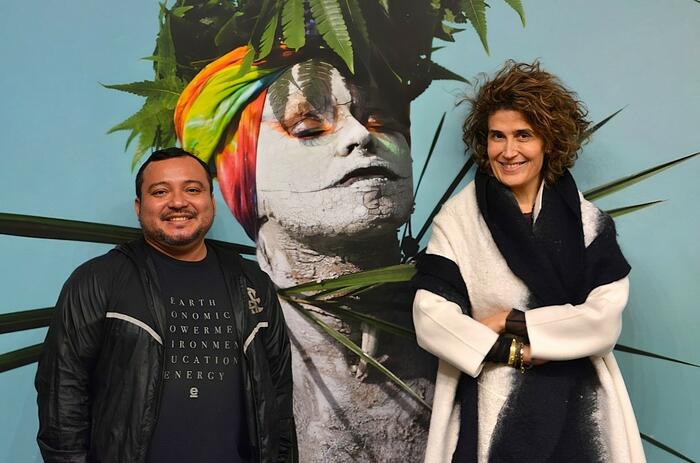
Maria Wills (Bogota, Colombia 1979) and Denilson Baniwa (Barcelos, Brazil, 1984) are the responsible for Wametisé: ideas for an amazofuturism, one of the special programs curated for ARCO 2025 and that navigates the Amazon and its growing impact on contemporary art. This proposal proposes a scenario of representation and dialogue through a selection of galleries and guest artists who will raise, through their works and their realities, the different conceptions of the Amazonian world and the possibilities of a collective future.
MARIA WILLS AND DENILSON BANIWA ON AMAZOFUTURISM
Maria Wills (Bogota, Colombia 1979) and Denilson Baniwa (Barcelos, Brazil, 1984) are the responsible for Wametisé: ideas for an amazofuturism, one of the special programs curated for ARCO 2025 and that navigates the Amazon and its growing impact on contemporary art. This proposal proposes a scenario of representation and dialogue through a selection of galleries and guest artists who will raise, through their works and their realities, the different conceptions of the Amazonian world and the possibilities of a collective future.

The Lima Art Museum (MALI) has announced the return of its emblematic event, thanks to the sponsorship of BBVA Global Wealth and RIMAC. The showcase will take place on February 21 at Playa del Golf, in the Asia beach resort.
CELEBRATING PERUVIAN ART: MALI'S SUMMER AUCTION RETURNS
The Lima Art Museum (MALI) has announced the return of its emblematic event, thanks to the sponsorship of BBVA Global Wealth and RIMAC. The showcase will take place on February 21 at Playa del Golf, in the Asia beach resort.

The work that Lúa Coderch (Iquitos, Peru, 1982) has been doing around language takes over her recent solo show at Madrid's The Ryder Projects to consolidate a new relational vision of communicative practices. Exhausted and exuberant, title of this partially retrospective and almost thesis exhibition, also responds to the two apparently opposite moods, but with an inexorable link, of the vital needs that seep into contemporary society between individuals and a certain extimacy that, organically, seems to have been imposed.
LANGUAGE AND SOCIETY IN LÚA CODERCH'S WORK AT THE RYDER
The work that Lúa Coderch (Iquitos, Peru, 1982) has been doing around language takes over her recent solo show at Madrid's The Ryder Projects to consolidate a new relational vision of communicative practices. Exhausted and exuberant, title of this partially retrospective and almost thesis exhibition, also responds to the two apparently opposite moods, but with an inexorable link, of the vital needs that seep into contemporary society between individuals and a certain extimacy that, organically, seems to have been imposed.

At Plaza Bolognesi, in the historic center of Lima, has opened GATO. Co-founded by Axier Villanueva and Oscar Flórit, this art platform seeks to sustain a dynamic, institutional-level program in a unique commercial environment.
GATO: THE GALLERY THAT SEEKS TO GENERATE NEW DIALOGUES IN PERU
At Plaza Bolognesi, in the historic center of Lima, has opened GATO. Co-founded by Axier Villanueva and Oscar Flórit, this art platform seeks to sustain a dynamic, institutional-level program in a unique commercial environment.

The VIGILGONZALES gallery presents Ansío lo que crece mientras cae (I Long for What Grows While Falling), an individual exhibition by Peruvian artist Natalia Iguiñiz Boggio; it highlights, both from a personal perspective and through historical reflection, the symbolic and epistemological aspects that uphold the vertical order of the patriarchal system.
VERTICAL ORDER AND CARDBOARD: NATALIA IGUIÑIZ AT VIGILGONZALES

Felipe Romero (Bogota, Colombia, 1992) usually shows in his photographic proposal a high interest in conflict zones. While the scenario reflects this palpable but still intangible tension, it also serves as a reflective framework where the conflict and its protagonists meet.
BORDER HOPELESSNESS THROUGH THE LENS OF FELIPE ROMERO
Felipe Romero (Bogota, Colombia, 1992) usually shows in his photographic proposal a high interest in conflict zones. While the scenario reflects this palpable but still intangible tension, it also serves as a reflective framework where the conflict and its protagonists meet.

The Museum of Contemporary Art of Lima (MAC) is organizing New Horizons of Digital Art, aimed at young people and adults, as part of the public program of the exhibition Artware 9. Lima Digital Art Biennial.
DIGITAL ART EXPANDS IN PERU
The Museum of Contemporary Art of Lima (MAC) is organizing New Horizons of Digital Art, aimed at young people and adults, as part of the public program of the exhibition Artware 9. Lima Digital Art Biennial.

The Broad Museum is set to present Jeffrey Gibson: the space in which to place me, a special exhibition showcasing the artist’s multidimensional work. Adapted from its original presentation at the U.S. Pavilion at the 60th Biennale in 2024, this exhibition marks a historic moment—Gibson was the first Indigenous artist to represent the United States with a solo exhibition.
JEFFREY GIBSON IN LOS ANGELES: A KALEIDOSCOPE OF IDENTITY AND RESISTANCE
The Broad Museum is set to present Jeffrey Gibson: the space in which to place me, a special exhibition showcasing the artist’s multidimensional work. Adapted from its original presentation at the U.S. Pavilion at the 60th Biennale in 2024, this exhibition marks a historic moment—Gibson was the first Indigenous artist to represent the United States with a solo exhibition.

The Guggenheim Museum Bilbao hosts a retrospective exhibition of Tarsila do Amaral (Capivari, Brazil, 1886 - São Paulo, Brazil, 1973) focused on her conception and renovation of painting, as well as on her recognition as one of the key and most representative figures of the entry of avant-garde and modernizing pictorial languages in Latin America. A central name in Brazilian modernism, her style was consecrated as her own identity, a product of her desires and experiences, evoking both indigenous themes and the modernizing processes of a Brazil that was undergoing a constant transformation.
THE MODERNITY OF TARSILA DO AMARAL TAKES OVER THE GUGGENHEIM IN BILBAO
The Guggenheim Museum Bilbao hosts a retrospective exhibition of Tarsila do Amaral (Capivari, Brazil, 1886 - São Paulo, Brazil, 1973) focused on her conception and renovation of painting, as well as on her recognition as one of the key and most representative figures of the entry of avant-garde and modernizing pictorial languages in Latin America. A central name in Brazilian modernism, her style was consecrated as her own identity, a product of her desires and experiences, evoking both indigenous themes and the modernizing processes of a Brazil that was undergoing a constant transformation.

Madrid-based Maisterravalbuena proposes a vindication of the work of Sarah Grilo (Buenos Aires, Argentina,1917 - Madrid, Spain, 2007) through Soluciones para pensar, the second exhibition on this artist at the gallery. With a didactic and rediscovery vocation, the exhibition gathers a selection of paintings in different formats made between the 1960s and 1990s, many of them unpublished to the public. This work of selection and direct work of the gallery with the archive and the legacy of the Argentinean artist becomes fundamental in the structuring of the objective of creating opportunities for a greater knowledge of Grilo's work.
(RE)DISCOVERING SARAH GRILO AT MAISTERRAVALBUENA
Madrid-based Maisterravalbuena proposes a vindication of the work of Sarah Grilo (Buenos Aires, Argentina,1917 - Madrid, Spain, 2007) through Soluciones para pensar, the second exhibition on this artist at the gallery. With a didactic and rediscovery vocation, the exhibition gathers a selection of paintings in different formats made between the 1960s and 1990s, many of them unpublished to the public. This work of selection and direct work of the gallery with the archive and the legacy of the Argentinean artist becomes fundamental in the structuring of the objective of creating opportunities for a greater knowledge of Grilo's work.

Madrid's CentroCentro approaches the artistic production related to the Amazon with the exhibition Trópico sin tópico: Amazonas (Tropic without Topic: Amazon), curated by Halim Badawi (Barranquilla, Colombia, 1982), and with which it intends to facilitate new looks beyond the usual ones with which the European imaginary contemplates the indigenous legacy and its relation with the contemporary world.
THE REVERSION OF AMAZONIAN CLICHÉS AT CENTROCENTRO
Madrid's CentroCentro approaches the artistic production related to the Amazon with the exhibition Trópico sin tópico: Amazonas (Tropic without Topic: Amazon), curated by Halim Badawi (Barranquilla, Colombia, 1982), and with which it intends to facilitate new looks beyond the usual ones with which the European imaginary contemplates the indigenous legacy and its relation with the contemporary world.

The intervention Wasi Llamkha (Place and touch), by artist Andrea Canepa (Lima, Peru, 1980), stands on the South Patio of Madrid's Condeduque. This pavilion, designed as an ephemeral architectural structure, invites us to explore its sensorial value, far from the preeminence of the visual, and claims, by way of inspiration, the quipus, the forms of representation and recording of information from pre-Columbian Peru.
SPACE AND SENSES IN ANDREA CANEPA
The intervention Wasi Llamkha (Place and touch), by artist Andrea Canepa (Lima, Peru, 1980), stands on the South Patio of Madrid's Condeduque. This pavilion, designed as an ephemeral architectural structure, invites us to explore its sensorial value, far from the preeminence of the visual, and claims, by way of inspiration, the quipus, the forms of representation and recording of information from pre-Columbian Peru.

Intricate between action and register, El Apartamento hosts Algo deja quien se va, the first solo exhibition in Spain by Reynier Leyva Novo (Havana, Cuba, 1983). Starting from the political concept of historical memory and linking it to the issues of power and colonialism, the artist unfolds in two well-differentiated series his proposal to approach these lines, and extends his networks to the impact (or influence) they have on the institutional and cultural fabric.
LEYVA NOVO: DUST IT IS AND TO DUST IT WILL TURN
Intricate between action and register, El Apartamento hosts Algo deja quien se va, the first solo exhibition in Spain by Reynier Leyva Novo (Havana, Cuba, 1983). Starting from the political concept of historical memory and linking it to the issues of power and colonialism, the artist unfolds in two well-differentiated series his proposal to approach these lines, and extends his networks to the impact (or influence) they have on the institutional and cultural fabric.

With an innovative perspective and a personal scenic language, KAY presents a play that reveals how the myths of the Amazon have been distorted to conceal the violence lurking over the women and girls of the region. The performance will serve as the closing event of the tenth edition of the prestigious theater and dance festival Temporada Alta, organized by the Alianza Francesa de Lima.
KAY EXPOSES "THE DARK SIDE OF COLLECTIVE MEMORIES" IN LIMA
With an innovative perspective and a personal scenic language, KAY presents a play that reveals how the myths of the Amazon have been distorted to conceal the violence lurking over the women and girls of the region. The performance will serve as the closing event of the tenth edition of the prestigious theater and dance festival Temporada Alta, organized by the Alianza Francesa de Lima.

Maria Wills (Bogota, Colombia 1979) and Denilson Baniwa (Barcelos, Brazil, 1984) are the responsible for Wametisé: ideas for an amazofuturism, one of the special programs curated for ARCO 2025 and that navigates the Amazon and its growing impact on contemporary art. This proposal proposes a scenario of representation and dialogue through a selection of galleries and guest artists who will raise, through their works and their realities, the different conceptions of the Amazonian world and the possibilities of a collective future.
MARIA WILLS AND DENILSON BANIWA ON AMAZOFUTURISM
Maria Wills (Bogota, Colombia 1979) and Denilson Baniwa (Barcelos, Brazil, 1984) are the responsible for Wametisé: ideas for an amazofuturism, one of the special programs curated for ARCO 2025 and that navigates the Amazon and its growing impact on contemporary art. This proposal proposes a scenario of representation and dialogue through a selection of galleries and guest artists who will raise, through their works and their realities, the different conceptions of the Amazonian world and the possibilities of a collective future.

The Lima Art Museum (MALI) has announced the return of its emblematic event, thanks to the sponsorship of BBVA Global Wealth and RIMAC. The showcase will take place on February 21 at Playa del Golf, in the Asia beach resort.
CELEBRATING PERUVIAN ART: MALI'S SUMMER AUCTION RETURNS
The Lima Art Museum (MALI) has announced the return of its emblematic event, thanks to the sponsorship of BBVA Global Wealth and RIMAC. The showcase will take place on February 21 at Playa del Golf, in the Asia beach resort.

The work that Lúa Coderch (Iquitos, Peru, 1982) has been doing around language takes over her recent solo show at Madrid's The Ryder Projects to consolidate a new relational vision of communicative practices. Exhausted and exuberant, title of this partially retrospective and almost thesis exhibition, also responds to the two apparently opposite moods, but with an inexorable link, of the vital needs that seep into contemporary society between individuals and a certain extimacy that, organically, seems to have been imposed.
LANGUAGE AND SOCIETY IN LÚA CODERCH'S WORK AT THE RYDER
The work that Lúa Coderch (Iquitos, Peru, 1982) has been doing around language takes over her recent solo show at Madrid's The Ryder Projects to consolidate a new relational vision of communicative practices. Exhausted and exuberant, title of this partially retrospective and almost thesis exhibition, also responds to the two apparently opposite moods, but with an inexorable link, of the vital needs that seep into contemporary society between individuals and a certain extimacy that, organically, seems to have been imposed.

At Plaza Bolognesi, in the historic center of Lima, has opened GATO. Co-founded by Axier Villanueva and Oscar Flórit, this art platform seeks to sustain a dynamic, institutional-level program in a unique commercial environment.
GATO: THE GALLERY THAT SEEKS TO GENERATE NEW DIALOGUES IN PERU
At Plaza Bolognesi, in the historic center of Lima, has opened GATO. Co-founded by Axier Villanueva and Oscar Flórit, this art platform seeks to sustain a dynamic, institutional-level program in a unique commercial environment.

The VIGILGONZALES gallery presents Ansío lo que crece mientras cae (I Long for What Grows While Falling), an individual exhibition by Peruvian artist Natalia Iguiñiz Boggio; it highlights, both from a personal perspective and through historical reflection, the symbolic and epistemological aspects that uphold the vertical order of the patriarchal system.
VERTICAL ORDER AND CARDBOARD: NATALIA IGUIÑIZ AT VIGILGONZALES

Felipe Romero (Bogota, Colombia, 1992) usually shows in his photographic proposal a high interest in conflict zones. While the scenario reflects this palpable but still intangible tension, it also serves as a reflective framework where the conflict and its protagonists meet.
BORDER HOPELESSNESS THROUGH THE LENS OF FELIPE ROMERO
Felipe Romero (Bogota, Colombia, 1992) usually shows in his photographic proposal a high interest in conflict zones. While the scenario reflects this palpable but still intangible tension, it also serves as a reflective framework where the conflict and its protagonists meet.

The Museum of Contemporary Art of Lima (MAC) is organizing New Horizons of Digital Art, aimed at young people and adults, as part of the public program of the exhibition Artware 9. Lima Digital Art Biennial.
DIGITAL ART EXPANDS IN PERU
The Museum of Contemporary Art of Lima (MAC) is organizing New Horizons of Digital Art, aimed at young people and adults, as part of the public program of the exhibition Artware 9. Lima Digital Art Biennial.

The Broad Museum is set to present Jeffrey Gibson: the space in which to place me, a special exhibition showcasing the artist’s multidimensional work. Adapted from its original presentation at the U.S. Pavilion at the 60th Biennale in 2024, this exhibition marks a historic moment—Gibson was the first Indigenous artist to represent the United States with a solo exhibition.
JEFFREY GIBSON IN LOS ANGELES: A KALEIDOSCOPE OF IDENTITY AND RESISTANCE
The Broad Museum is set to present Jeffrey Gibson: the space in which to place me, a special exhibition showcasing the artist’s multidimensional work. Adapted from its original presentation at the U.S. Pavilion at the 60th Biennale in 2024, this exhibition marks a historic moment—Gibson was the first Indigenous artist to represent the United States with a solo exhibition.

The Guggenheim Museum Bilbao hosts a retrospective exhibition of Tarsila do Amaral (Capivari, Brazil, 1886 - São Paulo, Brazil, 1973) focused on her conception and renovation of painting, as well as on her recognition as one of the key and most representative figures of the entry of avant-garde and modernizing pictorial languages in Latin America. A central name in Brazilian modernism, her style was consecrated as her own identity, a product of her desires and experiences, evoking both indigenous themes and the modernizing processes of a Brazil that was undergoing a constant transformation.
THE MODERNITY OF TARSILA DO AMARAL TAKES OVER THE GUGGENHEIM IN BILBAO
The Guggenheim Museum Bilbao hosts a retrospective exhibition of Tarsila do Amaral (Capivari, Brazil, 1886 - São Paulo, Brazil, 1973) focused on her conception and renovation of painting, as well as on her recognition as one of the key and most representative figures of the entry of avant-garde and modernizing pictorial languages in Latin America. A central name in Brazilian modernism, her style was consecrated as her own identity, a product of her desires and experiences, evoking both indigenous themes and the modernizing processes of a Brazil that was undergoing a constant transformation.

Madrid-based Maisterravalbuena proposes a vindication of the work of Sarah Grilo (Buenos Aires, Argentina,1917 - Madrid, Spain, 2007) through Soluciones para pensar, the second exhibition on this artist at the gallery. With a didactic and rediscovery vocation, the exhibition gathers a selection of paintings in different formats made between the 1960s and 1990s, many of them unpublished to the public. This work of selection and direct work of the gallery with the archive and the legacy of the Argentinean artist becomes fundamental in the structuring of the objective of creating opportunities for a greater knowledge of Grilo's work.
(RE)DISCOVERING SARAH GRILO AT MAISTERRAVALBUENA
Madrid-based Maisterravalbuena proposes a vindication of the work of Sarah Grilo (Buenos Aires, Argentina,1917 - Madrid, Spain, 2007) through Soluciones para pensar, the second exhibition on this artist at the gallery. With a didactic and rediscovery vocation, the exhibition gathers a selection of paintings in different formats made between the 1960s and 1990s, many of them unpublished to the public. This work of selection and direct work of the gallery with the archive and the legacy of the Argentinean artist becomes fundamental in the structuring of the objective of creating opportunities for a greater knowledge of Grilo's work.

Madrid's CentroCentro approaches the artistic production related to the Amazon with the exhibition Trópico sin tópico: Amazonas (Tropic without Topic: Amazon), curated by Halim Badawi (Barranquilla, Colombia, 1982), and with which it intends to facilitate new looks beyond the usual ones with which the European imaginary contemplates the indigenous legacy and its relation with the contemporary world.
THE REVERSION OF AMAZONIAN CLICHÉS AT CENTROCENTRO
Madrid's CentroCentro approaches the artistic production related to the Amazon with the exhibition Trópico sin tópico: Amazonas (Tropic without Topic: Amazon), curated by Halim Badawi (Barranquilla, Colombia, 1982), and with which it intends to facilitate new looks beyond the usual ones with which the European imaginary contemplates the indigenous legacy and its relation with the contemporary world.

The intervention Wasi Llamkha (Place and touch), by artist Andrea Canepa (Lima, Peru, 1980), stands on the South Patio of Madrid's Condeduque. This pavilion, designed as an ephemeral architectural structure, invites us to explore its sensorial value, far from the preeminence of the visual, and claims, by way of inspiration, the quipus, the forms of representation and recording of information from pre-Columbian Peru.
SPACE AND SENSES IN ANDREA CANEPA
The intervention Wasi Llamkha (Place and touch), by artist Andrea Canepa (Lima, Peru, 1980), stands on the South Patio of Madrid's Condeduque. This pavilion, designed as an ephemeral architectural structure, invites us to explore its sensorial value, far from the preeminence of the visual, and claims, by way of inspiration, the quipus, the forms of representation and recording of information from pre-Columbian Peru.

Intricate between action and register, El Apartamento hosts Algo deja quien se va, the first solo exhibition in Spain by Reynier Leyva Novo (Havana, Cuba, 1983). Starting from the political concept of historical memory and linking it to the issues of power and colonialism, the artist unfolds in two well-differentiated series his proposal to approach these lines, and extends his networks to the impact (or influence) they have on the institutional and cultural fabric.
LEYVA NOVO: DUST IT IS AND TO DUST IT WILL TURN
Intricate between action and register, El Apartamento hosts Algo deja quien se va, the first solo exhibition in Spain by Reynier Leyva Novo (Havana, Cuba, 1983). Starting from the political concept of historical memory and linking it to the issues of power and colonialism, the artist unfolds in two well-differentiated series his proposal to approach these lines, and extends his networks to the impact (or influence) they have on the institutional and cultural fabric.

With an innovative perspective and a personal scenic language, KAY presents a play that reveals how the myths of the Amazon have been distorted to conceal the violence lurking over the women and girls of the region. The performance will serve as the closing event of the tenth edition of the prestigious theater and dance festival Temporada Alta, organized by the Alianza Francesa de Lima.
KAY EXPOSES "THE DARK SIDE OF COLLECTIVE MEMORIES" IN LIMA
With an innovative perspective and a personal scenic language, KAY presents a play that reveals how the myths of the Amazon have been distorted to conceal the violence lurking over the women and girls of the region. The performance will serve as the closing event of the tenth edition of the prestigious theater and dance festival Temporada Alta, organized by the Alianza Francesa de Lima.

Maria Wills (Bogota, Colombia 1979) and Denilson Baniwa (Barcelos, Brazil, 1984) are the responsible for Wametisé: ideas for an amazofuturism, one of the special programs curated for ARCO 2025 and that navigates the Amazon and its growing impact on contemporary art. This proposal proposes a scenario of representation and dialogue through a selection of galleries and guest artists who will raise, through their works and their realities, the different conceptions of the Amazonian world and the possibilities of a collective future.
MARIA WILLS AND DENILSON BANIWA ON AMAZOFUTURISM
Maria Wills (Bogota, Colombia 1979) and Denilson Baniwa (Barcelos, Brazil, 1984) are the responsible for Wametisé: ideas for an amazofuturism, one of the special programs curated for ARCO 2025 and that navigates the Amazon and its growing impact on contemporary art. This proposal proposes a scenario of representation and dialogue through a selection of galleries and guest artists who will raise, through their works and their realities, the different conceptions of the Amazonian world and the possibilities of a collective future.

The Lima Art Museum (MALI) has announced the return of its emblematic event, thanks to the sponsorship of BBVA Global Wealth and RIMAC. The showcase will take place on February 21 at Playa del Golf, in the Asia beach resort.
CELEBRATING PERUVIAN ART: MALI'S SUMMER AUCTION RETURNS
The Lima Art Museum (MALI) has announced the return of its emblematic event, thanks to the sponsorship of BBVA Global Wealth and RIMAC. The showcase will take place on February 21 at Playa del Golf, in the Asia beach resort.

The work that Lúa Coderch (Iquitos, Peru, 1982) has been doing around language takes over her recent solo show at Madrid's The Ryder Projects to consolidate a new relational vision of communicative practices. Exhausted and exuberant, title of this partially retrospective and almost thesis exhibition, also responds to the two apparently opposite moods, but with an inexorable link, of the vital needs that seep into contemporary society between individuals and a certain extimacy that, organically, seems to have been imposed.
LANGUAGE AND SOCIETY IN LÚA CODERCH'S WORK AT THE RYDER
The work that Lúa Coderch (Iquitos, Peru, 1982) has been doing around language takes over her recent solo show at Madrid's The Ryder Projects to consolidate a new relational vision of communicative practices. Exhausted and exuberant, title of this partially retrospective and almost thesis exhibition, also responds to the two apparently opposite moods, but with an inexorable link, of the vital needs that seep into contemporary society between individuals and a certain extimacy that, organically, seems to have been imposed.

At Plaza Bolognesi, in the historic center of Lima, has opened GATO. Co-founded by Axier Villanueva and Oscar Flórit, this art platform seeks to sustain a dynamic, institutional-level program in a unique commercial environment.
GATO: THE GALLERY THAT SEEKS TO GENERATE NEW DIALOGUES IN PERU
At Plaza Bolognesi, in the historic center of Lima, has opened GATO. Co-founded by Axier Villanueva and Oscar Flórit, this art platform seeks to sustain a dynamic, institutional-level program in a unique commercial environment.

The VIGILGONZALES gallery presents Ansío lo que crece mientras cae (I Long for What Grows While Falling), an individual exhibition by Peruvian artist Natalia Iguiñiz Boggio; it highlights, both from a personal perspective and through historical reflection, the symbolic and epistemological aspects that uphold the vertical order of the patriarchal system.
VERTICAL ORDER AND CARDBOARD: NATALIA IGUIÑIZ AT VIGILGONZALES

Felipe Romero (Bogota, Colombia, 1992) usually shows in his photographic proposal a high interest in conflict zones. While the scenario reflects this palpable but still intangible tension, it also serves as a reflective framework where the conflict and its protagonists meet.
BORDER HOPELESSNESS THROUGH THE LENS OF FELIPE ROMERO
Felipe Romero (Bogota, Colombia, 1992) usually shows in his photographic proposal a high interest in conflict zones. While the scenario reflects this palpable but still intangible tension, it also serves as a reflective framework where the conflict and its protagonists meet.

The Museum of Contemporary Art of Lima (MAC) is organizing New Horizons of Digital Art, aimed at young people and adults, as part of the public program of the exhibition Artware 9. Lima Digital Art Biennial.
DIGITAL ART EXPANDS IN PERU
The Museum of Contemporary Art of Lima (MAC) is organizing New Horizons of Digital Art, aimed at young people and adults, as part of the public program of the exhibition Artware 9. Lima Digital Art Biennial.

The Broad Museum is set to present Jeffrey Gibson: the space in which to place me, a special exhibition showcasing the artist’s multidimensional work. Adapted from its original presentation at the U.S. Pavilion at the 60th Biennale in 2024, this exhibition marks a historic moment—Gibson was the first Indigenous artist to represent the United States with a solo exhibition.
JEFFREY GIBSON IN LOS ANGELES: A KALEIDOSCOPE OF IDENTITY AND RESISTANCE
The Broad Museum is set to present Jeffrey Gibson: the space in which to place me, a special exhibition showcasing the artist’s multidimensional work. Adapted from its original presentation at the U.S. Pavilion at the 60th Biennale in 2024, this exhibition marks a historic moment—Gibson was the first Indigenous artist to represent the United States with a solo exhibition.

The Guggenheim Museum Bilbao hosts a retrospective exhibition of Tarsila do Amaral (Capivari, Brazil, 1886 - São Paulo, Brazil, 1973) focused on her conception and renovation of painting, as well as on her recognition as one of the key and most representative figures of the entry of avant-garde and modernizing pictorial languages in Latin America. A central name in Brazilian modernism, her style was consecrated as her own identity, a product of her desires and experiences, evoking both indigenous themes and the modernizing processes of a Brazil that was undergoing a constant transformation.
THE MODERNITY OF TARSILA DO AMARAL TAKES OVER THE GUGGENHEIM IN BILBAO
The Guggenheim Museum Bilbao hosts a retrospective exhibition of Tarsila do Amaral (Capivari, Brazil, 1886 - São Paulo, Brazil, 1973) focused on her conception and renovation of painting, as well as on her recognition as one of the key and most representative figures of the entry of avant-garde and modernizing pictorial languages in Latin America. A central name in Brazilian modernism, her style was consecrated as her own identity, a product of her desires and experiences, evoking both indigenous themes and the modernizing processes of a Brazil that was undergoing a constant transformation.

Madrid-based Maisterravalbuena proposes a vindication of the work of Sarah Grilo (Buenos Aires, Argentina,1917 - Madrid, Spain, 2007) through Soluciones para pensar, the second exhibition on this artist at the gallery. With a didactic and rediscovery vocation, the exhibition gathers a selection of paintings in different formats made between the 1960s and 1990s, many of them unpublished to the public. This work of selection and direct work of the gallery with the archive and the legacy of the Argentinean artist becomes fundamental in the structuring of the objective of creating opportunities for a greater knowledge of Grilo's work.
(RE)DISCOVERING SARAH GRILO AT MAISTERRAVALBUENA
Madrid-based Maisterravalbuena proposes a vindication of the work of Sarah Grilo (Buenos Aires, Argentina,1917 - Madrid, Spain, 2007) through Soluciones para pensar, the second exhibition on this artist at the gallery. With a didactic and rediscovery vocation, the exhibition gathers a selection of paintings in different formats made between the 1960s and 1990s, many of them unpublished to the public. This work of selection and direct work of the gallery with the archive and the legacy of the Argentinean artist becomes fundamental in the structuring of the objective of creating opportunities for a greater knowledge of Grilo's work.

Madrid's CentroCentro approaches the artistic production related to the Amazon with the exhibition Trópico sin tópico: Amazonas (Tropic without Topic: Amazon), curated by Halim Badawi (Barranquilla, Colombia, 1982), and with which it intends to facilitate new looks beyond the usual ones with which the European imaginary contemplates the indigenous legacy and its relation with the contemporary world.
THE REVERSION OF AMAZONIAN CLICHÉS AT CENTROCENTRO
Madrid's CentroCentro approaches the artistic production related to the Amazon with the exhibition Trópico sin tópico: Amazonas (Tropic without Topic: Amazon), curated by Halim Badawi (Barranquilla, Colombia, 1982), and with which it intends to facilitate new looks beyond the usual ones with which the European imaginary contemplates the indigenous legacy and its relation with the contemporary world.

The intervention Wasi Llamkha (Place and touch), by artist Andrea Canepa (Lima, Peru, 1980), stands on the South Patio of Madrid's Condeduque. This pavilion, designed as an ephemeral architectural structure, invites us to explore its sensorial value, far from the preeminence of the visual, and claims, by way of inspiration, the quipus, the forms of representation and recording of information from pre-Columbian Peru.
SPACE AND SENSES IN ANDREA CANEPA
The intervention Wasi Llamkha (Place and touch), by artist Andrea Canepa (Lima, Peru, 1980), stands on the South Patio of Madrid's Condeduque. This pavilion, designed as an ephemeral architectural structure, invites us to explore its sensorial value, far from the preeminence of the visual, and claims, by way of inspiration, the quipus, the forms of representation and recording of information from pre-Columbian Peru.

Intricate between action and register, El Apartamento hosts Algo deja quien se va, the first solo exhibition in Spain by Reynier Leyva Novo (Havana, Cuba, 1983). Starting from the political concept of historical memory and linking it to the issues of power and colonialism, the artist unfolds in two well-differentiated series his proposal to approach these lines, and extends his networks to the impact (or influence) they have on the institutional and cultural fabric.
LEYVA NOVO: DUST IT IS AND TO DUST IT WILL TURN
Intricate between action and register, El Apartamento hosts Algo deja quien se va, the first solo exhibition in Spain by Reynier Leyva Novo (Havana, Cuba, 1983). Starting from the political concept of historical memory and linking it to the issues of power and colonialism, the artist unfolds in two well-differentiated series his proposal to approach these lines, and extends his networks to the impact (or influence) they have on the institutional and cultural fabric.

With an innovative perspective and a personal scenic language, KAY presents a play that reveals how the myths of the Amazon have been distorted to conceal the violence lurking over the women and girls of the region. The performance will serve as the closing event of the tenth edition of the prestigious theater and dance festival Temporada Alta, organized by the Alianza Francesa de Lima.
KAY EXPOSES "THE DARK SIDE OF COLLECTIVE MEMORIES" IN LIMA
With an innovative perspective and a personal scenic language, KAY presents a play that reveals how the myths of the Amazon have been distorted to conceal the violence lurking over the women and girls of the region. The performance will serve as the closing event of the tenth edition of the prestigious theater and dance festival Temporada Alta, organized by the Alianza Francesa de Lima.

Maria Wills (Bogota, Colombia 1979) and Denilson Baniwa (Barcelos, Brazil, 1984) are the responsible for Wametisé: ideas for an amazofuturism, one of the special programs curated for ARCO 2025 and that navigates the Amazon and its growing impact on contemporary art. This proposal proposes a scenario of representation and dialogue through a selection of galleries and guest artists who will raise, through their works and their realities, the different conceptions of the Amazonian world and the possibilities of a collective future.
MARIA WILLS AND DENILSON BANIWA ON AMAZOFUTURISM
Maria Wills (Bogota, Colombia 1979) and Denilson Baniwa (Barcelos, Brazil, 1984) are the responsible for Wametisé: ideas for an amazofuturism, one of the special programs curated for ARCO 2025 and that navigates the Amazon and its growing impact on contemporary art. This proposal proposes a scenario of representation and dialogue through a selection of galleries and guest artists who will raise, through their works and their realities, the different conceptions of the Amazonian world and the possibilities of a collective future.

The Lima Art Museum (MALI) has announced the return of its emblematic event, thanks to the sponsorship of BBVA Global Wealth and RIMAC. The showcase will take place on February 21 at Playa del Golf, in the Asia beach resort.
CELEBRATING PERUVIAN ART: MALI'S SUMMER AUCTION RETURNS
The Lima Art Museum (MALI) has announced the return of its emblematic event, thanks to the sponsorship of BBVA Global Wealth and RIMAC. The showcase will take place on February 21 at Playa del Golf, in the Asia beach resort.

The work that Lúa Coderch (Iquitos, Peru, 1982) has been doing around language takes over her recent solo show at Madrid's The Ryder Projects to consolidate a new relational vision of communicative practices. Exhausted and exuberant, title of this partially retrospective and almost thesis exhibition, also responds to the two apparently opposite moods, but with an inexorable link, of the vital needs that seep into contemporary society between individuals and a certain extimacy that, organically, seems to have been imposed.
LANGUAGE AND SOCIETY IN LÚA CODERCH'S WORK AT THE RYDER
The work that Lúa Coderch (Iquitos, Peru, 1982) has been doing around language takes over her recent solo show at Madrid's The Ryder Projects to consolidate a new relational vision of communicative practices. Exhausted and exuberant, title of this partially retrospective and almost thesis exhibition, also responds to the two apparently opposite moods, but with an inexorable link, of the vital needs that seep into contemporary society between individuals and a certain extimacy that, organically, seems to have been imposed.

At Plaza Bolognesi, in the historic center of Lima, has opened GATO. Co-founded by Axier Villanueva and Oscar Flórit, this art platform seeks to sustain a dynamic, institutional-level program in a unique commercial environment.
GATO: THE GALLERY THAT SEEKS TO GENERATE NEW DIALOGUES IN PERU
At Plaza Bolognesi, in the historic center of Lima, has opened GATO. Co-founded by Axier Villanueva and Oscar Flórit, this art platform seeks to sustain a dynamic, institutional-level program in a unique commercial environment.

The VIGILGONZALES gallery presents Ansío lo que crece mientras cae (I Long for What Grows While Falling), an individual exhibition by Peruvian artist Natalia Iguiñiz Boggio; it highlights, both from a personal perspective and through historical reflection, the symbolic and epistemological aspects that uphold the vertical order of the patriarchal system.
VERTICAL ORDER AND CARDBOARD: NATALIA IGUIÑIZ AT VIGILGONZALES

Felipe Romero (Bogota, Colombia, 1992) usually shows in his photographic proposal a high interest in conflict zones. While the scenario reflects this palpable but still intangible tension, it also serves as a reflective framework where the conflict and its protagonists meet.
BORDER HOPELESSNESS THROUGH THE LENS OF FELIPE ROMERO
Felipe Romero (Bogota, Colombia, 1992) usually shows in his photographic proposal a high interest in conflict zones. While the scenario reflects this palpable but still intangible tension, it also serves as a reflective framework where the conflict and its protagonists meet.

The Museum of Contemporary Art of Lima (MAC) is organizing New Horizons of Digital Art, aimed at young people and adults, as part of the public program of the exhibition Artware 9. Lima Digital Art Biennial.
DIGITAL ART EXPANDS IN PERU
The Museum of Contemporary Art of Lima (MAC) is organizing New Horizons of Digital Art, aimed at young people and adults, as part of the public program of the exhibition Artware 9. Lima Digital Art Biennial.

The Broad Museum is set to present Jeffrey Gibson: the space in which to place me, a special exhibition showcasing the artist’s multidimensional work. Adapted from its original presentation at the U.S. Pavilion at the 60th Biennale in 2024, this exhibition marks a historic moment—Gibson was the first Indigenous artist to represent the United States with a solo exhibition.
JEFFREY GIBSON IN LOS ANGELES: A KALEIDOSCOPE OF IDENTITY AND RESISTANCE
The Broad Museum is set to present Jeffrey Gibson: the space in which to place me, a special exhibition showcasing the artist’s multidimensional work. Adapted from its original presentation at the U.S. Pavilion at the 60th Biennale in 2024, this exhibition marks a historic moment—Gibson was the first Indigenous artist to represent the United States with a solo exhibition.

The Guggenheim Museum Bilbao hosts a retrospective exhibition of Tarsila do Amaral (Capivari, Brazil, 1886 - São Paulo, Brazil, 1973) focused on her conception and renovation of painting, as well as on her recognition as one of the key and most representative figures of the entry of avant-garde and modernizing pictorial languages in Latin America. A central name in Brazilian modernism, her style was consecrated as her own identity, a product of her desires and experiences, evoking both indigenous themes and the modernizing processes of a Brazil that was undergoing a constant transformation.
THE MODERNITY OF TARSILA DO AMARAL TAKES OVER THE GUGGENHEIM IN BILBAO
The Guggenheim Museum Bilbao hosts a retrospective exhibition of Tarsila do Amaral (Capivari, Brazil, 1886 - São Paulo, Brazil, 1973) focused on her conception and renovation of painting, as well as on her recognition as one of the key and most representative figures of the entry of avant-garde and modernizing pictorial languages in Latin America. A central name in Brazilian modernism, her style was consecrated as her own identity, a product of her desires and experiences, evoking both indigenous themes and the modernizing processes of a Brazil that was undergoing a constant transformation.

Madrid-based Maisterravalbuena proposes a vindication of the work of Sarah Grilo (Buenos Aires, Argentina,1917 - Madrid, Spain, 2007) through Soluciones para pensar, the second exhibition on this artist at the gallery. With a didactic and rediscovery vocation, the exhibition gathers a selection of paintings in different formats made between the 1960s and 1990s, many of them unpublished to the public. This work of selection and direct work of the gallery with the archive and the legacy of the Argentinean artist becomes fundamental in the structuring of the objective of creating opportunities for a greater knowledge of Grilo's work.
(RE)DISCOVERING SARAH GRILO AT MAISTERRAVALBUENA
Madrid-based Maisterravalbuena proposes a vindication of the work of Sarah Grilo (Buenos Aires, Argentina,1917 - Madrid, Spain, 2007) through Soluciones para pensar, the second exhibition on this artist at the gallery. With a didactic and rediscovery vocation, the exhibition gathers a selection of paintings in different formats made between the 1960s and 1990s, many of them unpublished to the public. This work of selection and direct work of the gallery with the archive and the legacy of the Argentinean artist becomes fundamental in the structuring of the objective of creating opportunities for a greater knowledge of Grilo's work.

Madrid's CentroCentro approaches the artistic production related to the Amazon with the exhibition Trópico sin tópico: Amazonas (Tropic without Topic: Amazon), curated by Halim Badawi (Barranquilla, Colombia, 1982), and with which it intends to facilitate new looks beyond the usual ones with which the European imaginary contemplates the indigenous legacy and its relation with the contemporary world.
THE REVERSION OF AMAZONIAN CLICHÉS AT CENTROCENTRO
Madrid's CentroCentro approaches the artistic production related to the Amazon with the exhibition Trópico sin tópico: Amazonas (Tropic without Topic: Amazon), curated by Halim Badawi (Barranquilla, Colombia, 1982), and with which it intends to facilitate new looks beyond the usual ones with which the European imaginary contemplates the indigenous legacy and its relation with the contemporary world.

The intervention Wasi Llamkha (Place and touch), by artist Andrea Canepa (Lima, Peru, 1980), stands on the South Patio of Madrid's Condeduque. This pavilion, designed as an ephemeral architectural structure, invites us to explore its sensorial value, far from the preeminence of the visual, and claims, by way of inspiration, the quipus, the forms of representation and recording of information from pre-Columbian Peru.
SPACE AND SENSES IN ANDREA CANEPA
The intervention Wasi Llamkha (Place and touch), by artist Andrea Canepa (Lima, Peru, 1980), stands on the South Patio of Madrid's Condeduque. This pavilion, designed as an ephemeral architectural structure, invites us to explore its sensorial value, far from the preeminence of the visual, and claims, by way of inspiration, the quipus, the forms of representation and recording of information from pre-Columbian Peru.

Intricate between action and register, El Apartamento hosts Algo deja quien se va, the first solo exhibition in Spain by Reynier Leyva Novo (Havana, Cuba, 1983). Starting from the political concept of historical memory and linking it to the issues of power and colonialism, the artist unfolds in two well-differentiated series his proposal to approach these lines, and extends his networks to the impact (or influence) they have on the institutional and cultural fabric.
LEYVA NOVO: DUST IT IS AND TO DUST IT WILL TURN
Intricate between action and register, El Apartamento hosts Algo deja quien se va, the first solo exhibition in Spain by Reynier Leyva Novo (Havana, Cuba, 1983). Starting from the political concept of historical memory and linking it to the issues of power and colonialism, the artist unfolds in two well-differentiated series his proposal to approach these lines, and extends his networks to the impact (or influence) they have on the institutional and cultural fabric.

With an innovative perspective and a personal scenic language, KAY presents a play that reveals how the myths of the Amazon have been distorted to conceal the violence lurking over the women and girls of the region. The performance will serve as the closing event of the tenth edition of the prestigious theater and dance festival Temporada Alta, organized by the Alianza Francesa de Lima.
KAY EXPOSES "THE DARK SIDE OF COLLECTIVE MEMORIES" IN LIMA
With an innovative perspective and a personal scenic language, KAY presents a play that reveals how the myths of the Amazon have been distorted to conceal the violence lurking over the women and girls of the region. The performance will serve as the closing event of the tenth edition of the prestigious theater and dance festival Temporada Alta, organized by the Alianza Francesa de Lima.

Maria Wills (Bogota, Colombia 1979) and Denilson Baniwa (Barcelos, Brazil, 1984) are the responsible for Wametisé: ideas for an amazofuturism, one of the special programs curated for ARCO 2025 and that navigates the Amazon and its growing impact on contemporary art. This proposal proposes a scenario of representation and dialogue through a selection of galleries and guest artists who will raise, through their works and their realities, the different conceptions of the Amazonian world and the possibilities of a collective future.
MARIA WILLS AND DENILSON BANIWA ON AMAZOFUTURISM
Maria Wills (Bogota, Colombia 1979) and Denilson Baniwa (Barcelos, Brazil, 1984) are the responsible for Wametisé: ideas for an amazofuturism, one of the special programs curated for ARCO 2025 and that navigates the Amazon and its growing impact on contemporary art. This proposal proposes a scenario of representation and dialogue through a selection of galleries and guest artists who will raise, through their works and their realities, the different conceptions of the Amazonian world and the possibilities of a collective future.

